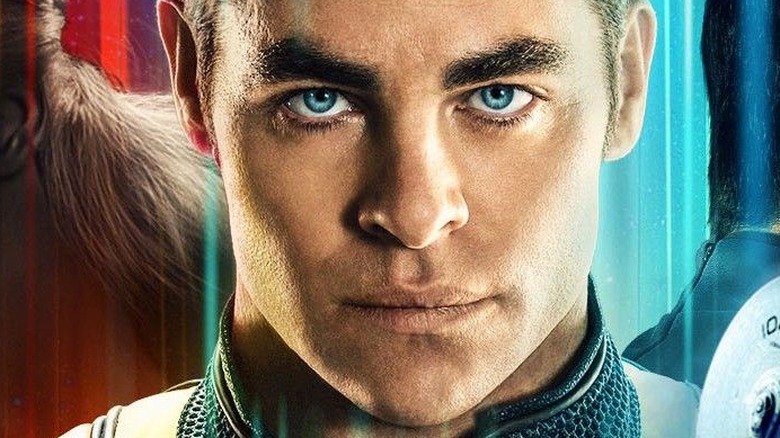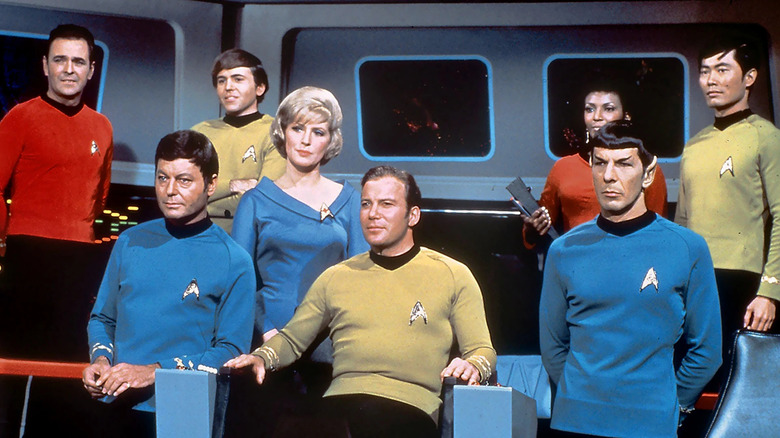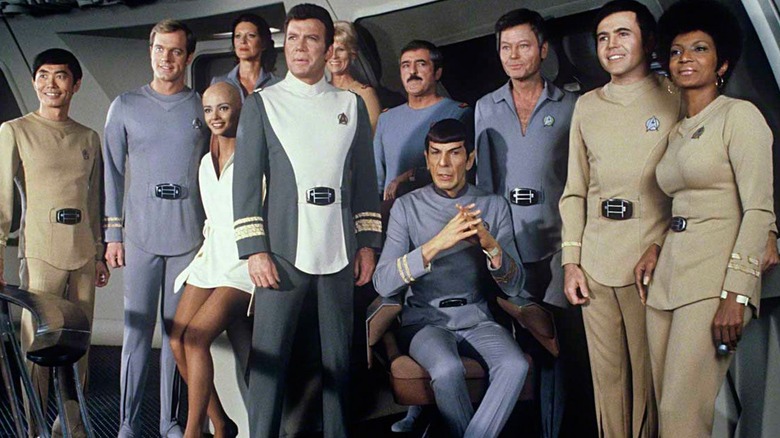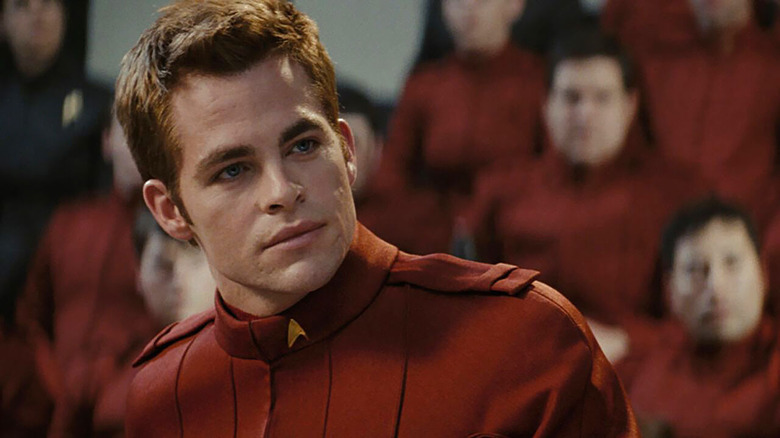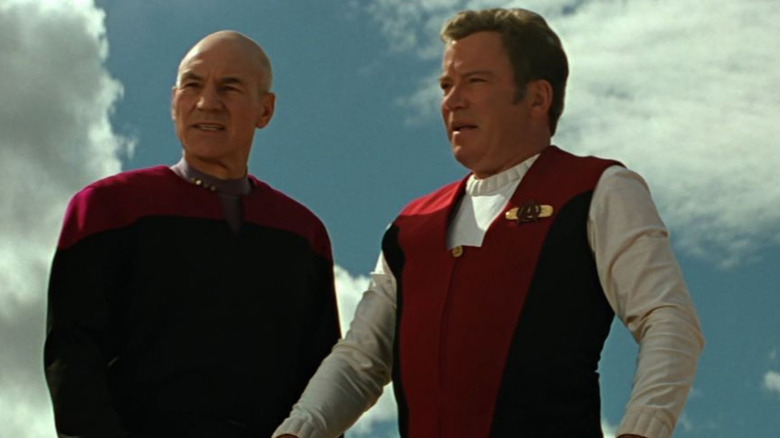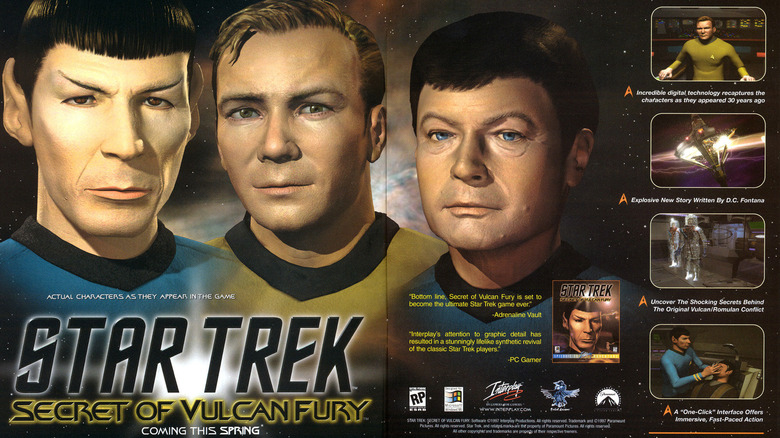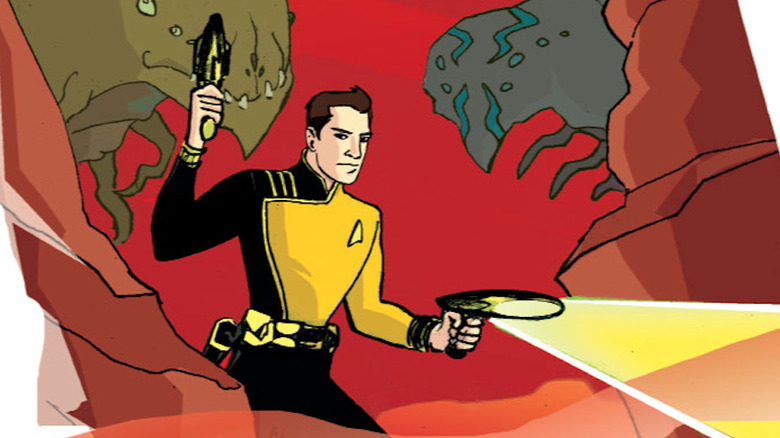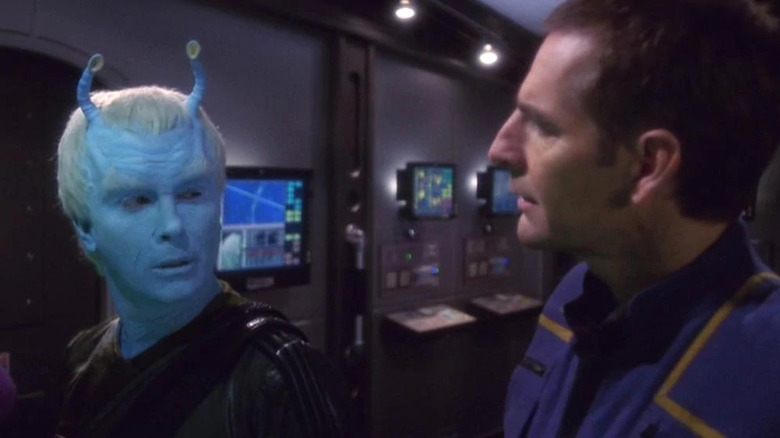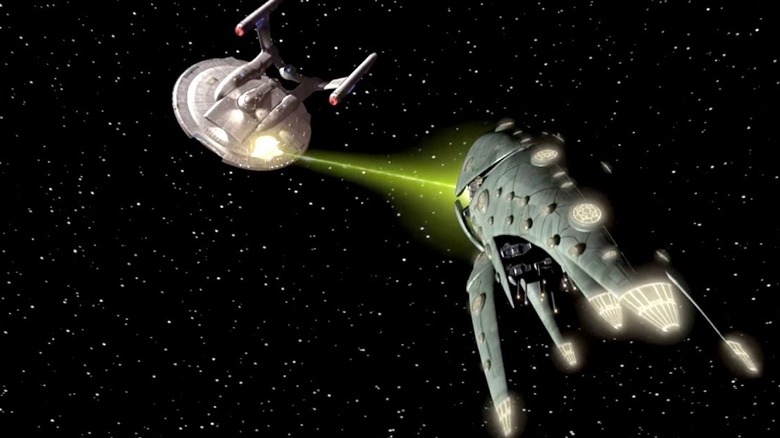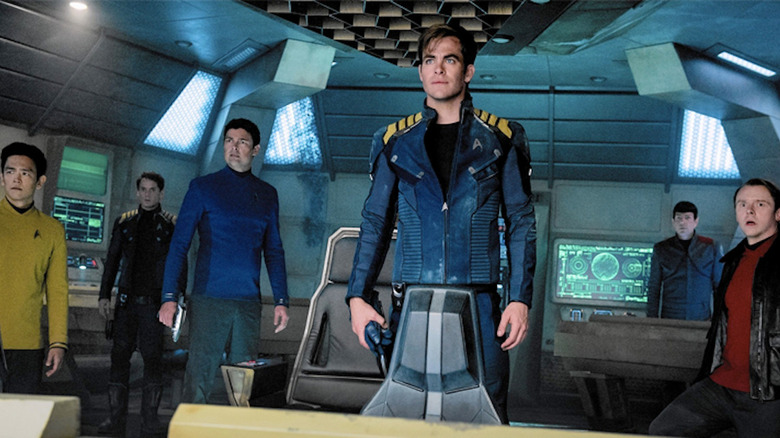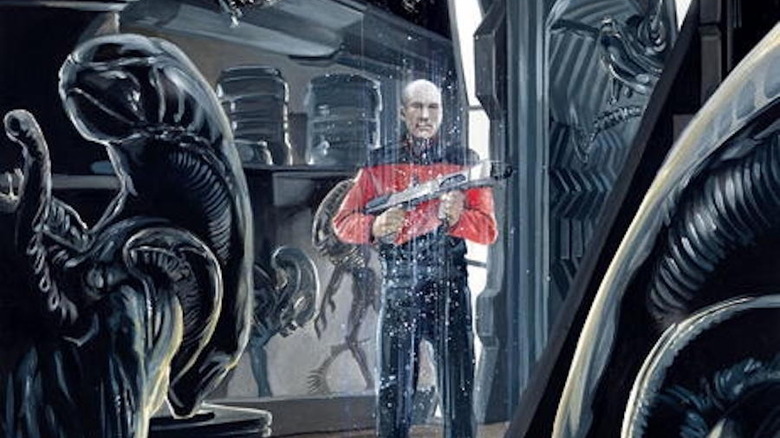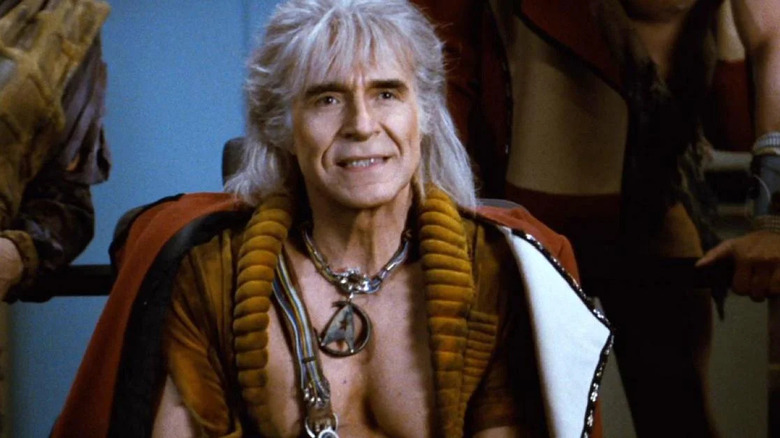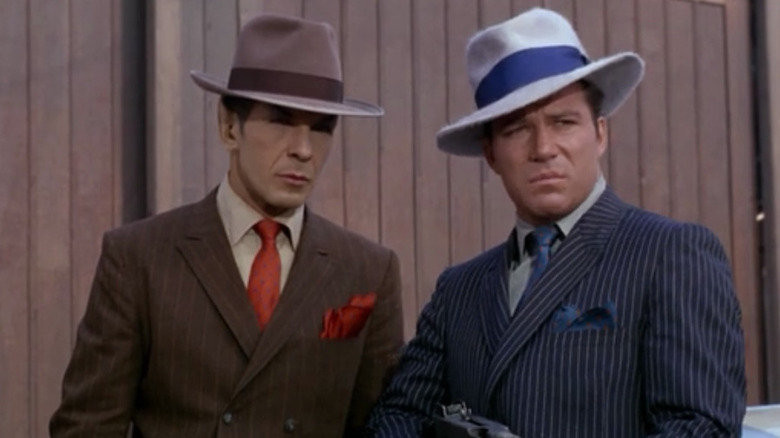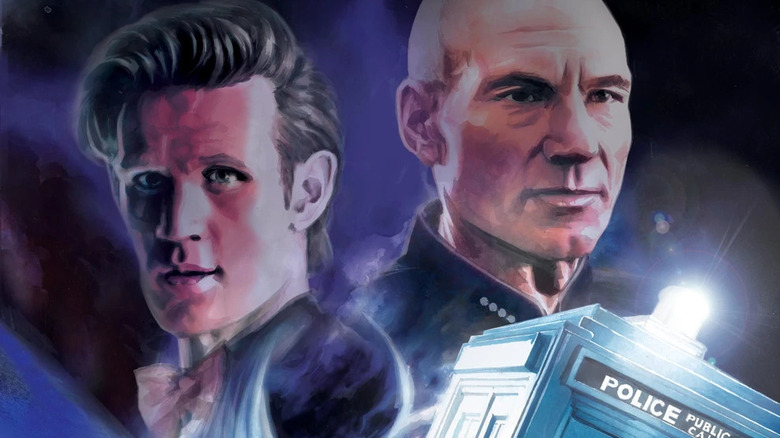Canceled Star Trek Projects You Never Knew About
The long-running "Star Trek" franchise has seen plenty of action on screens big and small over its nearly 60-year history. It's yielded nearly a dozen television series and 13 movies since its launch in 1966, with more in the planning stages. From big-budget action adventures to thoughtful exploration of the human spirit in outer space, "Star Trek" has done it all. Beyond the screen too, there are books, comics, video games, even audio dramas, that have continued to, in the words of its two most famous captains, "explore strange new worlds, seek out new life and new civilizations, and boldly go where no one has gone before."
But for every project we see, there are more that are planned and never produced. We've heard actor Michael Dorn's idea for a "Captain Worf" TV series, but what about the projects that nearly happened, or had a real chance of being made, and fell apart or came to a halt before they came to fruition? Well you're in luck, because we've got a list for you of the canceled "Star Trek" projects that you've probably never heard about.
Planet Of The Titans
As early as 1975, when "Star Trek" was doing well in reruns, creator Gene Roddenberry was hard at work on turning his original TV series into a feature film. One of his first attempts, a script titled "The God Thing," wasn't getting very far, but another story, titled "Planet Of The Titans," had gone into development before the studio would shift gears to a revived television series (but more on that later). This new film, written by Chris Bryant and Alan Scott, would have been directed by Philip Kaufman and followed Kirk, Spock, and the crew of the Enterprise as they discovered "a lost race with super technology" who had played a mysterious role in Earth's history.
Surprisingly, the film got well into pre-production and had a wealth of concept art produced, notably by "Star Wars" illustrator Ralph McQuarrie. McQuarrie would even redesign the iconic Enterprise, giving it a large flat, triangular-shaped secondary hull — a design that would be resurrected in 2017 for "Star Trek: Discovery." In fact, the film was far enough along that it was officially announced to the public, with director Kaufman appearing at a "Star Trek" convention where the news was given to cheering throngs of fans.
Legendary actor Toshiro Mifune was eyed for the role of the Klingon villain, and sets were being planned, when a call came down from the studio that, according to Kaufman, "there's no future in science fiction" and the film was off. A year later, "Star Wars" would debut, and "Star Trek: The Motion Picture" would be given the green light, arriving in 1979.
Star Trek: Phase II
Around the same time that "Planet Of The Titans" was in heavy pre-production, Paramount execs were in serious discussions about starting their own television network at a time when there were only three: ABC, CBS, and NBC. Barry Diller, then President of Paramount, thought that a new "Star Trek" television series would be the perfect show to launch the network, as the series was still wildly popular in syndication. After the "Planet Of The Titans" movie was canceled, Diller told Gene Roddenberry to begin work on a new series instead, which would ultimately be titled "Star Trek: Phase II." (via Hollywood Reporter)
This new series would be set on a remodeled version of the Enterprise, and feature almost all the original cast with a handful of new additions. Despite heavy lobbying, actor Leonard Nimoy was not interested in returning to play Spock, so a new Vulcan crew member, Xon, was created to take his place. At least 13 scripts were written and pre-production was in full swing until it became clear that the planned Paramount network would not be able to meet its advertising revenue goals.
Thankfully, the astronomical success of "Star Wars" at the box office led the studio to resurrect the sagging concept as a big-budget theatrical release. The pilot script, "In Thy Image," was reworked and expanded to become "Star Trek: The Motion Picture." Two other episodes, "The Child" and "Devil's Due," were overhauled and used on "Star Trek: The Next Generation" a decade later.
Star Trek: The Academy Years
Following the disastrous critical and commercial drubbing suffered by "Star Trek V: The Final Frontier" in 1989, the studio was probably wondering if there was still gas left in the tank for the franchise's original stars. Instead of a sequel, Paramount began work on a potential follow-up called "Star Trek: The Academy Years" that got some real traction within the studio before being axed.
The project was dreamed up by longtime "Trek" movie producer Harve Bennett, who saw it as a way of continuing the franchise by recasting the roles and telling the story of how Kirk and Spock first met at Starfleet Academy. According to Bennett, in an interview with StarTrek.com in 2010, the script was complete and the studio had greenlit the project. They'd even been circling actors Ethan Hawke and John Cusack for the roles of Kirk and Spock, while concept art for an early version of the Enterprise bore a strong similarity to the one seen later on the prequel series "Enterprise." The film would have also featured bookend scenes with William Shatner and Leonard Nimoy as Kirk and Spock, leaving the door open to also continue their adventures.
Ultimately, Nicholas Meyer, who had so successfully revived the franchise with "Star Trek II: the Wrath Of Khan," returned to co-write and direct a sixth and final film with the entire original cast, "Star Trek VI: The Undiscovered Country," which sent the series out on a high note. But Bennett insisted that "The Academy Years" was a stellar script and lamented that it was never made.
The alternate Generations
With "Star Trek: The Next Generation" coming to a close after its seventh season in 1994, work was already underway for the cast of that series to transition to the big screen. The studio wanted the new film to be a "passing of the torch" with the original series' Captain Kirk returning to meet "TNG" star Captain Picard in a cross-generational adventure. It was a critical film that could very well determine the future of the "Star Trek" franchise, so it had been rumored for years that producer Rick Berman actually commissioned two competing scripts. The one that was produced, by longtime series writers Ron Moore and Brannon Braga, saw Kirk teaming up with Picard to stop an intergalactic villain.
But a second concept, by TV writer Maurice Hurley — who had written for "TNG" early in its run — was also developed but never got past the script stage. After decades of hearsay, the existence of a second script was confirmed by a tweet from Berman in 2014. Though story details have never been officially released, it was rumored that Picard and the Enterprise had to contend with a massive space anomaly threatening the galaxy. According to online chatter, the meeting between Kirk and Picard happened in the holodeck, where Picard recreated Kirk to get advice from his Enterprise predecessor. Whether coincidence or not, this seems eerily similar to the series finale of "Star Trek: Enterprise," written by Braga, where Commander Riker is seen interacting with Captain Archer and the NX-01 Enterprise on the holodeck to help him solve a problem aboard the Enterprise-D.
Secret Of Vulcan Fury
Television shows and movies aren't the only high-profile "Star Trek" projects that have been abandoned. In the late 1990s, a number of video games were canceled while in production, including "Star Trek: Borg Assimilator." But the most notable canceled game would have brought back the original crew for a new adventure. Titled "Star Trek: Secret Of Vulcan Fury," the game would have used cutting-edge 3D technology to recreate the likenesses of Captain Kirk, Mr. Spock, and others in a story planned to explore the schism between the Romulans and Vulcans.
According to a 1997 profile of the game in Computer Gaming World, the story and full video scenes would have been produced by veteran "Star Trek" scribe D.C. Fontana and TV director John Meredyth-Lucas, both of whom had worked on "Star Trek: The Original Series." The entire cast would have reprised their roles in what was designed and promoted as a new episode of the original "Star Trek" series. The story would have opened with the murder of a Romulan Ambassador being escorted by the Enterprise to Vulcan for peace talks.
But in a 2015 interview, Rebecca Heineman, one of the game's designers, said that the technology used to scan the actors proved far too expensive to make the game cost-effective: "No one had ever actually sat down to say, 'How much would this cost per minute to generate this footage?'" Despite the actors having all recorded their dialogue, the costs skyrocketed, and the company pulled the plug.
Star Trek: Final Frontier
In the mid-1970s, seven years after the original "Star Trek" series ended in 1969, the franchise returned to television as a short-lived — and oft-overlooked — animated series. Following the cancellation of "Star Trek: Enterprise" in 2005, Paramount seems to have had similar ideas on reinvigorating the franchise, and was working on a web-based animated series titled "Star Trek: Final Frontier." Several exciting comic book-style pieces of production art were drawn up, including character designs, ships, and environments, before Paramount put the kibosh on the proposed series.
Set in the 26th century, some 200 years after "The Next Generation," "Final Frontier" would have introduced a world of upheaval for the Federation, still reeling from a horrific war with the Romulans more than half a century earlier. Playing off a concept introduced in "Star Trek: Voyager," the war had seen the detonation of Omega Particles that ravaged subspace and prevented warp travel through large regions of Federation territory, leading to the crumbling of the once mighty multi-species organization. Decades later, Captain Alexander Chase would lead a mission to bring the Federation back to its former glory.
Planned as a series of web-based five-to-six-minute shorts, it sounded exciting to many longtime fans. But it never got much past the design stage, and fell quietly into the dustbin of history. Of course, its premise once again bears a striking (though likely coincidental) similarity to the story seen in Seasons 3 and 4 of "Star Trek: Discovery."
Star Trek: Enterprise Season 5
The fourth "Star Trek" spin-off, "Star Trek: Enterprise," launched in 2001 as a striking departure from previous series, set 100 years before the era of Kirk and Spock. There was no United Federation of Planets, barely a Starfleet to speak of, and the experimental Enterprise was Earth's only starship exploring deep space. Although led by established TV star Scott Bakula, the show struggled in the ratings for its entire run, and cancellation seemed to loom at the end of nearly every season. Its third season saw a retooling of sorts, introducing a season-long war story, while the fourth year brought a new showrunner with radical new ideas.
Despite their best efforts, however, the show was canceled after its fourth season. But showrunner Manny Coto had plans in place for a fifth season that never saw the light of day. Hopeful that the series would be picked up, Coto developed new episodes, discussing the proposed stories in an online chat in 2005 that was published later by TrekToday.
Stories on the drawing board included the construction of the first Earth starbases, plus a conclusion to the Temporal Cold War storyline that had never been resolved. Most exciting was the proposed continuation of the story seen in the two-part Season 4 episode set in the mirror universe, which he called "a series within a series." A newly redesigned Enterprise refit was also planned, created by series artist Doug Drexler.
Star Trek: The Beginning
Even before "Star Trek: Enterprise" aired its final episode in May of 2005, work was already underway on a new "Star Trek" feature film. The planned project, "Star Trek: The Beginning" was being written by Erik Jendresen, lead writer behind the award-winning miniseries "Band Of Brothers." Like that HBO production, the "Trek" film he was dreaming up was said to have been a similarly-toned war movie, taking place in the direct aftermath of "Enterprise" as a sprawling conflict between humans and Romulans began brewing.
In a 2005 interview with Jendresen at SyFyPortal.com, the writer revealed a little bit about the project. "We're going [roughly 80] years before Kirk," he explained. "It's an earlier time, and I think it would be really refreshing to feel something in the course of telling this tale, instead of being wowed by special effects." This would be a film with consequences, Jendresen revealed, adding, "By the end of this story, everyone isn't fine."
According to leaked details published by AintItCoolNews, the film would have been a wild departure from traditional "Trek," featuring an all-new set of characters and patterned after classic World War II epics. With a broad narrative and large ensemble cast, it would have followed more than one ship in the Earth's starfleet as they fought the Romulans. But the project was swept under the rug in the wake of a change in leadership at Paramount, paving the way for the J.J. Abrams reboot and leaving us all to wonder what could have been.
Star Trek: Federation
Around the same time that Erik Jendresen was working on his script for a new "Star Trek" movie, the studio was also brainstorming ways of continuing the franchise on television despite the cancellation of "Star Trek: Enterprise." In 2006, "X-Men" director Bryan Singer, then hard at work on "Superman Returns," began developing his own pitch for a new series, titled "Star Trek: Federation." A self-described fan of "Star Trek," Singer had worked with "The Next Generation" star Patrick Stewart in the "X-Men" movies for Fox, and even made a blink-and-miss-it cameo in the 2002 film "Star Trek: Nemesis" as Lieutenant Kelly, an officer on the Enterprise's bridge.
As explained by Slashfilm in 2011, Singer's concept was set in the year 3000 — nearly 800 years after Kirk and Spock. In this far-flung future the United Federation of Planets is in decline, and unprepared when a new galactic menace called the Scourge suddenly attacks. A new Enterprise is quickly commissioned to lead the fight, with a first officer named Commander Kirk — an apparent descendent of the classic Enterprise captain. Despite the big-name director attached, the proposed series never really went very far, though writer Robert Meyer Burnett worked with Singer and "Mission: Impossible" screenwriter Christopher McQuarrie on a 25-page series proposal.
Before the pitch was even made to the studio, however, Paramount announced the J.J. Abrams movie reboot, choosing to focus on a series of new movies instead of a new television series.
Star Trek/Aliens: Acceptable Losses
Trekkies have been dreaming of sci-fi crossovers for decades. whether it's Captain Kirk meeting Luke Skywalker, or Malcolm Reynolds' Serenity docking at Deep Space Nine. There have been a number of such crossovers in comics books, but one major franchise crossover from IDW Publishing that almost happened in 2017 was called off shortly before its planned release. It would have seen Captain Picard and the Enterprise-D coming into contact with the xenomorphs from the "Alien" franchise, in a story that seems to evoke shades of "Star Trek: First Contact." The project would have also been an inter-company collaboration between IDW, which held the "Star Trek" license from Paramount, and Dark Horse Comics, which held the license for "Aliens" from Fox (via CNET).
Announced at the 2016 MCM London Comic Con, the series was to have been written by brothers Scott and David Tipton, and illustrated by artist JK Woodward, the same creative team behind the "Star Trek/Doctor Who: Assimilation2" crossover also published by IDW. Several pieces of art were completed for the series, and even circulated online, with an announced release date of April 2017. But not long before it was due to hit shelves, the series was abruptly cancelled, as announced by a Dark Horse employee on social media. No explanation was ever given, but it's possible — if not likely — that it involved complicated rights and licensing issues, considering the two different media giants and two rival publishing companies involved.
Star Trek: Khan limited series
In 2016, not long after the first new "Star Trek" series in more than a decade had been greenlit by CBS Television, the studio announced that writer-director Nicholas Meyer was joining the writing team for the then-untitled series (via Deadline). The director of two classic "Star Trek" feature films, including the celebrated "Star Trek II: The Wrath Of Khan," Meyer's appointment was cheered by fans. Not long after, the fans were surprised and excited when it was reported that Meyer's work on "Star Trek" might extend past the new series, into a possible new movie or spin-off television show.
Though no series from Meyer ever materialized, the writer commented on his proposed project more recently, revealing that his other project was a spin-off prequel centered on the villain Khan. In a 2018 interview, Meyer had commented that the power struggle at Paramount and CBS during recent merger talks had put his project on the back burner. "I don't think my project is going anywhere in a hurry," he said. "Because everything is being [put] on hold, while they sort out this merger business."
Three years later, Meyer admitted that the project was effectively dead. Proposed as a three-part mini-series, Meyer speculated that the project's relatively small scope was why it never came to fruition. "What happened was that the business model for streaming was changing really fast," he explained. "And what was originally commissioned as a three-hour or three-night event, by the time I finished writing it, three hours was not enough. They wanted longer stuff."
Quentin Tarantino's Star Trek movie
Trekkies were surprised to learn in late 2017 that auteur writer/director Quentin Tarantino was in talks with Paramount Studios to produce the next installment in the franchise. With Tarantino showing a passing interest in writing and even directing a "Star Trek" movie, Paramount leapt at the opportunity to snag the Hollywood icon, and it wasn't long before a deal was signed and a script was in active development.
Based on a concept from Tarantino himself, the story sounds like it would have been inspired by the classic "Star Trek" episode "A Piece Of The Action," where Kirk, Spock, and the Enterprise visit an alien planet that is somehow modeled after 1920s Chicago, mobsters and all. Described by Tarantino as "'Pulp Fiction' in space" it was planned as an R-rated, ultra-violent take on the classic sci-fi series, unlike anything we'd seen before.
Tarantino had openly expressed his affection for "Star Trek," and it was rumored that his new film would retain the cast of the J.J. Abrams movies, with Chris Pine and Zachary Quinto as Kirk and Spock. But as the months and years dragged on with the project in development, Tarantino's interest seemed to wane: first he dropped out as director, then it was reported that the film was no longer happening. This is the one project on this list that always seemed like a longshot to begin with, so few were surprised when the idea was shelved in favor of "Star Trek 4," with "WandaVision" director Matt Shakman behind the camera.
Doctor Who/Star Trek episode
While inter-company crossovers are not uncommon for "Star Trek" in comic books or even novels, the closest the franchise has ever come to one in live-action was an episode of the 1980s sitcom "Webster," in which the title character met Lieutenant Worf aboard the Enterprise in a daydream. But one such massive sci-fi crossover might have happened in the mid-2000s. It began with the revival of the BBC icon "Doctor Who" in 2005 by writer-producer Russell T. Davies. While the first season of the revived "Doctor Who" was in production, "Star Trek: Enterprise" was airing its fourth and final season, and Davies dreamed of having the Doctor land the TARDIS on the bridge of the Enterprise.
"I would have loved to have done a 'Star Trek' crossover. The very first year, we talked about it," said Davies in a 2009 interview with the UK Times that was published on TrekMovie a year later. But before they could even develop the concept, "Enterprise" was canceled, and the idea of crossing over the two legendary franchises seemed moot.
These days, "Star Trek" is back on TV with multiple streaming series in production, Russel T. Davies is once against showrunner on "Doctor Who." With both shows undergoing a renaissance, perhaps there's still a chance he'll dust off his old proposal and make the dream crossover a reality.
